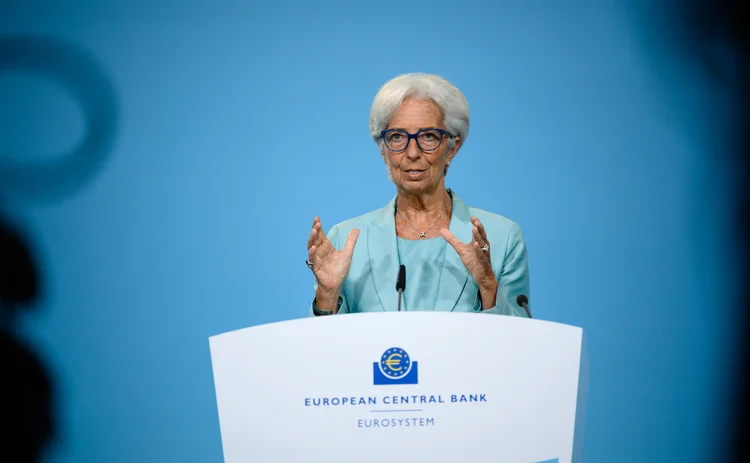ECB’s Lagarde sets out vision for integrated European capital market
The president of the European Central Bank argues for a more ambitious, top-down approach to the capital markets union.

Christine Lagarde knows a thing or two about crises. She became France’s Finance and Economy Minister in the summer of 2007, just as the first tremors of the subprime mortgage crisis were being felt in France. She later took up the mantle of managing director at the International Monetary Fund amid a corporate governance scandal after her predecessor, Dominique Strauss-Kahn, was arrested on allegations of sexual assault. And then she became president of the European Central Bank in November 2019, right in time for the Covid-19 pandemic.
But now, exactly halfway through her eight-year term at the ECB, Lagarde has put crisis management to one side to look at the bigger picture.
In a speech last week at the European Banking Congress, she outlined some “key ingredients” for deeper, more integrated European capital markets. Her suggestions included a single rulebook for markets across the region, concentrating enforcement powers in the hands of a single regulator, and consolidating market infrastructures.
Although this represents a step up in the rhetoric surrounding integration, Virginie O’Shea, founder and CEO of Firebrand Research, points out that the desire to increase EU-level oversight of the region’s markets is nothing new. “As you can see with the gradual extension of Esma’s power over time to directly regulate entities such as trade repositories and ratings agencies, some movements have been made in that direction already,” she says.
When it first became a policy objective in 2014, the capital markets union (CMU) initiative aimed to create a single, unified European capital market within five years. But almost 10 years later, Europe’s markets are still divided. Lagarde recognized in her speech that the European equity and bond markets are only half and one third the size of their US counterparts, respectively, and that Europe has roughly 20 times as many post-trade infrastructure providers.
The EU also has local regulators in 27 individual member states, a patchwork of tax regimes, and more than 25 different settlement markets. As well as deterring potential investors, this complex market structure makes it harder to implement new regulation, a challenge which the European Securities and Markets Authority (Esma) acknowledged in its recent call for evidence on shortening settlement cycles.
Peter Tomlinson, director of post trade at the Association for Financial Markets in Europe (Afme) told WatersTechnology that, “if you draw a process diagram for the US, it’s like a single motorway. The EU equivalent is more of a spaghetti junction.”
The US cropped up often in Lagarde’s speech to illustrate the power of an integrated capital market. Specifically, she pointed to the construction of the railway in the 19th century, when the country turned to bonds to finance a project that was beyond the scope of a fragmented banking system.
Lagarde suggested that a similar pivot would help Europe to relieve some of the pressure on its bank-based financial system. “Banks will have a central role to play, but we cannot expect them to take on so much risk on their balance sheets,” she said.
Ingredients for integration
The problem, according to Lagarde’s diagnosis, is that the EU has taken a “bottom-up” approach to implementing the CMU—developing regional markets to meet local needs and then working to stitch them together. “Piecemeal changes to legislation have systematically tackled obstacles or inconsistencies in areas ranging from clearing systems and sustainability disclosures to retail investment and investment funds,” she said.
Sam Riley, CEO of European central securities depository Clearstream, adds that cross-border transactions within Europe can still pose problems for some investors. Clearstream created an investor CSD model in 2018, allowing an international investor to access European T2S settlement in, for example, Spanish, Italian, or French stocks without an account with the local CSD. But this model is still nascent in Europe, with Clearstream representing more than 90% of cross-border transactions.
“Part of that was because there were inhibitors in place. And I think that’s slowly changing,” Riley tells WatersTechnology. “We’ve got requests in with the European Central Bank on how to improve that as we move forward, which they will address over the next couple of years. From our perspective, we can still do more in Europe to be able to take down some of those barriers, at least in the post-trade world.”
Lagarde, too, called for a more holistic approach, designing a financial system that caters to the entire European market. This would mean a single rulebook for European markets, protected by one regulator with authority to enforce rules across the continent, in the style of the US Securities and Exchange Commission.
“Creating a European SEC—for example by extending the powers of Esma—could be the answer. It would need a broad mandate—including direct supervision—to mitigate systemic risks posed by large cross-border firms and market infrastructures such as EU central counterparties,” she said.
Stephane Malrait, head of market structure and innovation at Dutch bank ING, says that transactions are currently reported in two different places: a public tape for post-trade transparency, and the local regulator for trade and market abuse monitoring.
“This private transaction reporting activity that we do for our own regulator in Holland, a French bank will do in France, and a Spanish bank in Spain. So it’s very hard for [each regulator] to know, ‘ING is buying all those bonds, and a French bank is selling all those bonds.’ They will not have that view, because currently they only receive one part of the European universe.”
In the US, on the other hand, the SEC receives all transaction reports, meaning it is better placed to identify unusual market events and coordinate responses.
Anders Borg, Sweden’s former Minister of Finance, echoed Lagarde’s calls for greater harmonization of regulation across Europe in his keynote speech at Regnology’s Regtech Convention this week, with a particular focus on the collection of granular data by banking supervisors.
“A European SEC would offer greater depth of capital markets and create a more supportive environment for growth across the Eurozone,” he tells WatersTechnology.
Lagarde also called for consolidated market infrastructures driven by private sector investment. In particular, she highlighted the project to build a consolidated tape—a live stream of trade data from venues across Europe. This resource could “encourage a shift towards larger, cross-border integrated market infrastructure and exchange groups,” she said, adding that smaller stock exchanges that join together in broader groups tend to perform better.
“There is this momentum at the ECB level with Christine Lagarde, at the European Commission level, even at Esma, to start thinking more globally as a region,” Malrait says. “The consolidated tape is an important step, it will give a lot of transparency. But we have to start to think about step two, step three, etcetera.”
Although there is clearly political will to reform Europe’s fragmented markets, the scale of such a job would be daunting. Europe’s tripartite legislative process requires agreement between the Commission, the Council (comprising of governments of European countries), and Parliament (representatives to Europe specially elected in member states). These bodies often have competing agendas, with the Council typically focused on national priorities and the Parliament concentrating more on the European picture.
The difficulty of reaching consensus in the European system was highlighted by the drawn-out three-way negotiations needed to thrash out a deal on consolidated tapes this year. The co-legislators argued about what data the tapes should include, how it should be distributed, and how the tender process should be run. The three houses finally reached a deal in the dying days of Sweden’s presidency of the Council of the EU (a rotating post), only to pass a host of new questions to their successors who had to decide on the technical minutiae—such as how data quality problems would be remedied and how venues must connect to the tape.
Now, almost 50 years after the US set up its consolidated tapes, Europe is edging closer to its own golden source of pricing data. But the time it took to resolve the questions surrounding this relatively uncontentious infrastructure serve as a reminder of how difficult it is to implement far-reaching changes.
Firebrand’s O’Shea is skeptical that either the call for a beefed-up regulator or the prospect of “a single exchange to rule them all” is likely to come to fruition. “The EU contains competing markets, and they don’t all have exactly the same political viewpoints, market priorities, or, for that matter, regulatory agendas. The SEC regulates a single market, with a single government and within a relatively harmonized arena (although obviously there are some state-by-state nuances). The EU is simply too complex from a political standpoint for a single enforcement regulator across the wide purview that the SEC has,” she says.
Further reading
Only users who have a paid subscription or are part of a corporate subscription are able to print or copy content.
To access these options, along with all other subscription benefits, please contact info@waterstechnology.com or view our subscription options here: http://subscriptions.waterstechnology.com/subscribe
You are currently unable to print this content. Please contact info@waterstechnology.com to find out more.
You are currently unable to copy this content. Please contact info@waterstechnology.com to find out more.
Copyright Infopro Digital Limited. All rights reserved.
As outlined in our terms and conditions, https://www.infopro-digital.com/terms-and-conditions/subscriptions/ (point 2.4), printing is limited to a single copy.
If you would like to purchase additional rights please email info@waterstechnology.com
Copyright Infopro Digital Limited. All rights reserved.
You may share this content using our article tools. As outlined in our terms and conditions, https://www.infopro-digital.com/terms-and-conditions/subscriptions/ (clause 2.4), an Authorised User may only make one copy of the materials for their own personal use. You must also comply with the restrictions in clause 2.5.
If you would like to purchase additional rights please email info@waterstechnology.com
More on Regulation
Off-channel messaging (and regulators) still a massive headache for banks
Waters Wrap: Anthony wonders why US regulators are waging a war using fines, while European regulators have chosen a less draconian path.
Banks fret over vendor contracts as Dora deadline looms
Thousands of vendor contracts will need repapering to comply with EU’s new digital resilience rules
Chevron’s absence leaves questions for elusive AI regulation in US
The US Supreme Court’s decision to overturn the Chevron deference presents unique considerations for potential AI rules.
Aussie asset managers struggle to meet ‘bank-like’ collateral, margin obligations
New margin and collateral requirements imposed by UMR and its regulator, Apra, are forcing buy-side firms to find tools to help.
The costly sanctions risks hiding in your supply chain
In an age of geopolitical instability and rising fines, financial firms need to dig deep into the securities they invest in and the issuing company’s network of suppliers and associates.
Industry associations say ECB cloud guidelines clash with EU’s Dora
Responses from industry participants on the European Central Bank’s guidelines are expected in the coming weeks.
Regulators recommend Figi over Cusip, Isin for reporting in FDTA proposal
Another contentious battle in the world of identifiers pits the Figi against Cusip and the Isin, with regulators including the Fed, the SEC, and the CFTC so far backing the Figi.
US Supreme Court clips SEC’s wings with recent rulings
The Supreme Court made a host of decisions at the start of July that spell trouble for regulators—including the SEC.








